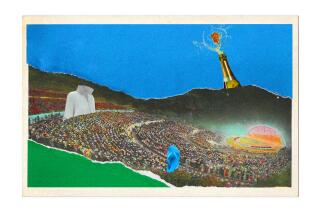Collector of Bowling Exotica : Alley Fan Keeps Eye Out for Odd Balls
- Share via
“Bowl Them Over,” says the World War II poster, which depicts the faces of Hitler, Mussolini and Tojo on bowling pins. A nearby photo shows a sad-eyed horse about to boot a bowling ball down a lane. Another snapshot features the bowling shirt of a funeral home’s team, whose logo is an arm protruding from a casket, ball in hand.
Tommy Steele’s studio is not the spare room of your average bowling fan.
When Steele gets the urge to indulge his love for the sport, he doesn’t go out to the nearest lanes. He heads to a junk shop, swap meet or garage sale.
Steele, 32--featured in one book, “The Passionate Collector,” and author of another, “Bowl-O-Rama”--hunts for bowling exotica.
“One of the things I admire about bowlers is their ability to laugh at themselves, and you have to admit that some of these things are pretty funny,” said Steele the other day, pointing to such treasures as a bowling ball that opens up into a liquor decanter, earrings shaped like bowling pins and a weather vane with a bowler on top.
“The curves of the pin are a pleasant form, too,” he added.
Steele was clad in one of the 50 second-hand bowling shirts he owns, a multicolored job that bore the name tag “Floyd.”
The back of the shirt said “South Dakota Singing Legionnaires” and bore the faces of the four Presidents carved on Mt. Rushmore--none of whom, Steele pointed out, ever adorned the cover of Kegler magazine, as did a southpaw successor, Harry S. Truman.
He fingered the shirt fondly. “Great material,” he said, “not like the new shirts, made out of those polyester blends.”
He never bowls in a bowling shirt, and he explained why:
“I’m not good enough,” he said, adding that he’s never broken 200. “I’d feel too self-conscious.”
In fact, though he began bowling as a child, his favorite memories of those days aren’t of clutch strikes and converted seven-ten splits.
“What I loved was the ‘40s- and ‘50s-style architecture of the alleys,” said Steele, a record-album designer who’s also written a book about Hawaiian shirts.
“There was a naivete, a certain kind of purity, that’s no longer present. For instance, the Llo Da Mar in Santa Monica. (Actor) Harold Lloyd was one of the owners. It had pink neon pins and balls on the ceiling. It’s gone now. So are most of the others that had the wild neon designs and the places where the name might be spelled out on the outside with bowling balls. The rising real estate values are driving them out.”
Problems at Picwood
The latest to fold, he pointed out, was the Picwood Bowl in West Los Angeles. Fortunately the Picwood was assured a bit of immortality a few years earlier when singer-actress Mary Kay Place posed in front of it for the cover of a record album. (Steele designed the cover.)
Vanishing, too, is the term “bowling alley.”
“I guess they think ‘alley’ has a bad connotation--the drinking, smoking and gambling in basements that went on in the early days,” Steele said. “Now they’re ‘family centers’ or ‘Such and Such Lanes.’ And alleys are becoming computerized. Your score is registered automatically while you bowl. I always liked keeping my own score.”
Steele recently assembled his bowling exotica into his book, which is a kind of cultural study of the sport. The photographs depict such wonders as a bowling ball-shaped car in South Euclid, Ohio, and a 40-foot-high bowling pin that fronted a bowling manufacturer in Glendale until the company knocked it down a decade ago.
Bowling Language
No tales of historic tournaments and perfect 300-games in Steele’s book--though there is a glossary containing such terms as “grandma’s teeth” (a random array of pins left standing) and “barmaid” (a pin hidden behind another pin).
Bowling, Steele says, appears to date back at least 7,000 years, the approximate age of three balls and nine pin-like objects found in an Egyptian tomb. (None of the pins was standing, by the way.)
Steele’s book displays some of the startling discoveries he has found that link the sport with the art world . . . a bowling-pin table at a gallery here . . . an Edward Ruscha painting, “Blue Bowling Ball,” now housed in a Texas bank . . . a restaurant in West Hollywood, Palette, that offers bowling-ball decor.
There is “something aesthetically satisfying,” Steele theorizes, about the “pure organic elements and proportions of ball to pin.”
Even if the ball and pin are contained in a cigarette lighter that says, “Strike!”
More to Read
Go beyond the scoreboard
Get the latest on L.A.'s teams in the daily Sports Report newsletter.
You may occasionally receive promotional content from the Los Angeles Times.










